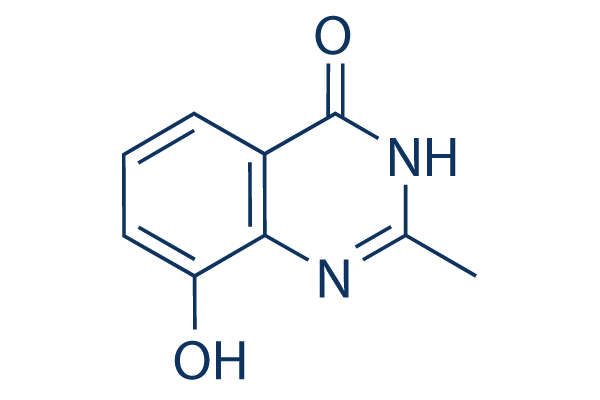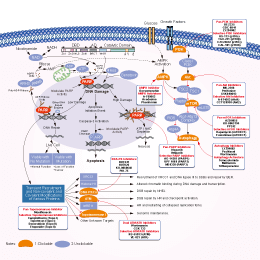
- Bioactive Compounds
- By Signaling Pathways
- PI3K/Akt/mTOR
- Epigenetics
- Methylation
- Immunology & Inflammation
- Protein Tyrosine Kinase
- Angiogenesis
- Apoptosis
- Autophagy
- ER stress & UPR
- JAK/STAT
- MAPK
- Cytoskeletal Signaling
- Cell Cycle
- TGF-beta/Smad
- Compound Libraries
- Popular Compound Libraries
- Customize Library
- Clinical and FDA-approved Related
- Bioactive Compound Libraries
- Inhibitor Related
- Natural Product Related
- Metabolism Related
- Cell Death Related
- By Signaling Pathway
- By Disease
- Anti-infection and Antiviral Related
- Neuronal and Immunology Related
- Fragment and Covalent Related
- FDA-approved Drug Library
- FDA-approved & Passed Phase I Drug Library
- Preclinical/Clinical Compound Library
- Bioactive Compound Library-I
- Bioactive Compound Library-Ⅱ
- Kinase Inhibitor Library
- Express-Pick Library
- Natural Product Library
- Human Endogenous Metabolite Compound Library
- Alkaloid Compound LibraryNew
- Angiogenesis Related compound Library
- Anti-Aging Compound Library
- Anti-alzheimer Disease Compound Library
- Antibiotics compound Library
- Anti-cancer Compound Library
- Anti-cancer Compound Library-Ⅱ
- Anti-cancer Metabolism Compound Library
- Anti-Cardiovascular Disease Compound Library
- Anti-diabetic Compound Library
- Anti-infection Compound Library
- Antioxidant Compound Library
- Anti-parasitic Compound Library
- Antiviral Compound Library
- Apoptosis Compound Library
- Autophagy Compound Library
- Calcium Channel Blocker LibraryNew
- Cambridge Cancer Compound Library
- Carbohydrate Metabolism Compound LibraryNew
- Cell Cycle compound library
- CNS-Penetrant Compound Library
- Covalent Inhibitor Library
- Cytokine Inhibitor LibraryNew
- Cytoskeletal Signaling Pathway Compound Library
- DNA Damage/DNA Repair compound Library
- Drug-like Compound Library
- Endoplasmic Reticulum Stress Compound Library
- Epigenetics Compound Library
- Exosome Secretion Related Compound LibraryNew
- FDA-approved Anticancer Drug LibraryNew
- Ferroptosis Compound Library
- Flavonoid Compound Library
- Fragment Library
- Glutamine Metabolism Compound Library
- Glycolysis Compound Library
- GPCR Compound Library
- Gut Microbial Metabolite Library
- HIF-1 Signaling Pathway Compound Library
- Highly Selective Inhibitor Library
- Histone modification compound library
- HTS Library for Drug Discovery
- Human Hormone Related Compound LibraryNew
- Human Transcription Factor Compound LibraryNew
- Immunology/Inflammation Compound Library
- Inhibitor Library
- Ion Channel Ligand Library
- JAK/STAT compound library
- Lipid Metabolism Compound LibraryNew
- Macrocyclic Compound Library
- MAPK Inhibitor Library
- Medicine Food Homology Compound Library
- Metabolism Compound Library
- Methylation Compound Library
- Mouse Metabolite Compound LibraryNew
- Natural Organic Compound Library
- Neuronal Signaling Compound Library
- NF-κB Signaling Compound Library
- Nucleoside Analogue Library
- Obesity Compound Library
- Oxidative Stress Compound LibraryNew
- Plant Extract Library
- Phenotypic Screening Library
- PI3K/Akt Inhibitor Library
- Protease Inhibitor Library
- Protein-protein Interaction Inhibitor Library
- Pyroptosis Compound Library
- Small Molecule Immuno-Oncology Compound Library
- Mitochondria-Targeted Compound LibraryNew
- Stem Cell Differentiation Compound LibraryNew
- Stem Cell Signaling Compound Library
- Natural Phenol Compound LibraryNew
- Natural Terpenoid Compound LibraryNew
- TGF-beta/Smad compound library
- Traditional Chinese Medicine Library
- Tyrosine Kinase Inhibitor Library
- Ubiquitination Compound Library
-
Cherry Picking
You can personalize your library with chemicals from within Selleck's inventory. Build the right library for your research endeavors by choosing from compounds in all of our available libraries.
Please contact us at [email protected] to customize your library.
You could select:
- Antibodies
- Bioreagents
- qPCR
- 2x SYBR Green qPCR Master Mix
- 2x SYBR Green qPCR Master Mix(Low ROX)
- 2x SYBR Green qPCR Master Mix(High ROX)
- Protein Assay
- Protein A/G Magnetic Beads for IP
- Anti-Flag magnetic beads
- Anti-Flag Affinity Gel
- Anti-Myc magnetic beads
- Anti-HA magnetic beads
- Poly FLAG Peptide lyophilized powder
- Protease Inhibitor Cocktail
- Protease Inhibitor Cocktail (EDTA-Free, 100X in DMSO)
- Phosphatase Inhibitor Cocktail (2 Tubes, 100X)
- Cell Biology
- Cell Counting Kit-8 (CCK-8)
- Animal Experiment
- Mouse Direct PCR Kit (For Genotyping)
- New Products
- Contact Us
NU1025
Synonyms: NSC 696807
NU1025 (NSC 696807) is a potent PARP inhibitor with IC50 of 400 nM.

NU1025 Chemical Structure
CAS: 90417-38-2
Selleck's NU1025 has been cited by 2 publications
Purity & Quality Control
Batch:
Purity:
99.29%
99.29
NU1025 Related Products
| Related Targets | PARP1 PARP2 PARP3 Tankyrase-1 Tankyrase-2 PARP14 PARP7 TNKS1 TNKS2 | Click to Expand |
|---|---|---|
| Related Products | Olaparib (AZD2281) XAV-939 Veliparib (ABT-888) Talazoparib (BMN 673) Rucaparib phosphate Niraparib (MK-4827) PJ34 HCl Rucaparib Niraparib tosylate AG-14361 Iniparib (BSI-201) Rucaparib Camsylate A-966492 G007-LK UPF 1069 AZD2461 Pamiparib ME0328 3-Aminobenzamide NMS-P118 Stenoparib (E7449) NVP-TNKS656 WIKI4 Benzamide BGP-15 2HCl BYK204165 Fluzoparib (SHR-3162) Picolinamide | Click to Expand |
| Related Compound Libraries | FDA-approved Drug Library Natural Product Library Apoptosis Compound Library DNA Damage/DNA Repair compound Library Cell Cycle compound library | Click to Expand |
Signaling Pathway
Choose Selective PARP Inhibitors
Biological Activity
| Description | NU1025 (NSC 696807) is a potent PARP inhibitor with IC50 of 400 nM. | ||
|---|---|---|---|
| Targets |
|
| In vitro | ||||
| In vitro | NU1025 (0.2 mM) treatment attenuates H2O2 induced cytotoxicity. NU1025 per se does not have any effect on cell viability. NU1025 pretreatment significantly increases cell viability (82.59 ?4.67%) in SIN-1 (0.8 mM) exposed cells.[2] NU1025 has no detectable effect on the proliferation of D54 and U251 cells. Treatment with NU1025 markedly inhibits the enhanced activation of PARP-1 induced by TPT and RT treatment.[3] No DNA strand breakage is detected following exposure to 200 µM NU1025 alone.[4] | |||
|---|---|---|---|---|
| Kinase Assay | PARP activation assay | |||
| Cells are suspended in hypotonic buffer (9 mM HEPES, pH 7.8, 4.5% (v/v) dextran, 4.5 mM MgCl2 and 5 mM DTT) at 1.5 × 107/mL on ice for 30 min, then 9 vol of isotonic buffer (40 mM HEPES, pH 7.8, 130 mM KCl, 4% (v/v) dextran, 2 mM EGTA, 2.3 mM MgCl2, 225 mM sucrose and 2.5 mM DTT) is added. The reaction is started by adding 300 µL cells to 100 µL 300 µM NAD+ containing [32P]-NAD+, and terminated by the addition of 2 mL ice-cold 10% (w/v) TCA +10% (w/v) sodium pyrophosphate. After 30 min on ice the precipitated 32P-labelled ADP-ribose polymers are filtered, washed five times with 1% (v/v) TCA, 1% (v/v) sodium pyrophosphate, dried and counted. | ||||
| Cell Research | Cell lines | D54 and U251 cells | ||
| Concentrations | 160 μM | |||
| Incubation Time | 5 days | |||
| Method | Cells are seeded in 96-well plates at a density of 2,500 cells/well and treated with the indicated doses of NU1025. Adherent cells are irradiated in medium with 250 kVp X-rays (dose rate 0.5 Gy/min). Untreated cells are used as a control. Following an up to 5 day incubation, cell proliferation is assessed by MTT assay. | |||
| In Vivo | ||
| In vivo | Treatment with NU1025 (1 and 3 mg/kg) reduces the infarction to 25% and 45% versus vehicle treated rats, respectively. NU1025 (1 and 3 mg/kg) treatment significantly reduces edema volume. NU1025 also produces significant improvement in neurological deficits.[2] | |
|---|---|---|
| Animal Research | Animal Models | Male Sprague Dawley rats |
| Dosages | 3 mg/kg | |
| Administration | i.p. | |
Chemical Information & Solubility
| Molecular Weight | 176.17 | Formula | C9H8N2O2 |
| CAS No. | 90417-38-2 | SDF | Download NU1025 SDF |
| Smiles | CC1=NC2=C(C=CC=C2O)C(=O)N1 | ||
| Storage (From the date of receipt) | |||
|
In vitro |
DMSO : 35 mg/mL ( (198.67 mM); Moisture-absorbing DMSO reduces solubility. Please use fresh DMSO.) Ethanol : 6 mg/mL Water : Insoluble |
Molecular Weight Calculator |
|
In vivo Add solvents to the product individually and in order. |
In vivo Formulation Calculator |
||||
Preparing Stock Solutions
Molarity Calculator
In vivo Formulation Calculator (Clear solution)
Step 1: Enter information below (Recommended: An additional animal making an allowance for loss during the experiment)
mg/kg
g
μL
Step 2: Enter the in vivo formulation (This is only the calculator, not formulation. Please contact us first if there is no in vivo formulation at the solubility Section.)
% DMSO
%
% Tween 80
% ddH2O
%DMSO
%
Calculation results:
Working concentration: mg/ml;
Method for preparing DMSO master liquid: mg drug pre-dissolved in μL DMSO ( Master liquid concentration mg/mL, Please contact us first if the concentration exceeds the DMSO solubility of the batch of drug. )
Method for preparing in vivo formulation: Take μL DMSO master liquid, next addμL PEG300, mix and clarify, next addμL Tween 80, mix and clarify, next add μL ddH2O, mix and clarify.
Method for preparing in vivo formulation: Take μL DMSO master liquid, next add μL Corn oil, mix and clarify.
Note: 1. Please make sure the liquid is clear before adding the next solvent.
2. Be sure to add the solvent(s) in order. You must ensure that the solution obtained, in the previous addition, is a clear solution before proceeding to add the next solvent. Physical methods such
as vortex, ultrasound or hot water bath can be used to aid dissolving.
Tech Support
Answers to questions you may have can be found in the inhibitor handling instructions. Topics include how to prepare stock solutions, how to store inhibitors, and issues that need special attention for cell-based assays and animal experiments.
Tel: +1-832-582-8158 Ext:3
If you have any other enquiries, please leave a message.
* Indicates a Required Field
Tags: buy NU1025 | NU1025 supplier | purchase NU1025 | NU1025 cost | NU1025 manufacturer | order NU1025 | NU1025 distributor








































